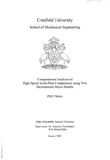JavaScript is disabled for your browser. Some features of this site may not work without it.
| dc.contributor.advisor | Elder, R. L. | |
| dc.contributor.advisor | Tourlidakis, A. | |
| dc.contributor.author | Amaral Teixeira, J. A. | |
| dc.date.accessioned | 2020-04-02T11:10:06Z | |
| dc.date.available | 2020-04-02T11:10:06Z | |
| dc.date.issued | 2002-01 | |
| dc.identifier.uri | http://dspace.lib.cranfield.ac.uk/handle/1826/15359 | |
| dc.description.abstract | The employment of CFD methods for the analysis of multistage turbomachinery flows is restricted for the foreseeable future to steady-state methods of which the most widespread one employs the mixing-plane approach. The last method nevertheless is known to introduce jumps in some quantities at the stage interface due to the unphysical pitchwise averaging process it models and when employed in the simulation of multi-stage machines leads to a progressive downstream degradation of the solution accuracy. Adamczk’s average-passage equation system is the steady-state approach which fundamentally overcomes these limitations but the requirement that a set of machine- wide domains be iteratively solved as part of the calculation of each of the rows of interest, entails large computational requirements. A far more economical solution is to combine some of Adamczyk’s equation terms accounting for the cyclic components of the unsteady stage effects, the deterministic stress terms, with a mixing-plane steady-state formulation. This is the approach taken by the two semi- empirical models which were employed in this work to study two high-speed axial- flow compressor configurations, the single-stage Rolls-Royce HP9 and the novel three stage Cranfield University High Speed Research Compressor. The Hall and the Bolger deterministic stress models were combined with the CFD turbomachinery code CFX-TASCflow via a Source Code Interface and results were obtained for the two cases with and without the application of the models. Although the impact of the addition of deterministic stress terms to the solution of HP9 is noticeable but small, these effects are in the Cranfield machine more noticeable and seen to offer some contribution towards the approximation of the computational to the experimental global performance results. | en_UK |
| dc.language.iso | en | en_UK |
| dc.rights | © Cranfield University, 2015. All rights reserved. No part of this publication may be reproduced without the written permission of the copyright holder. | |
| dc.title | Computational analysis of high-speed axial-flow compressors using two deterministic stress models | en_UK |
| dc.type | Thesis | en_UK |
